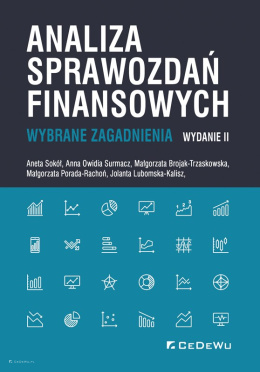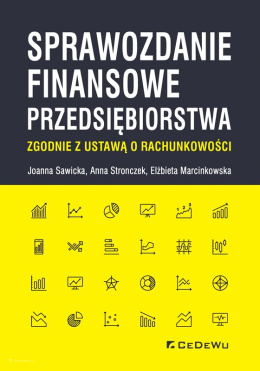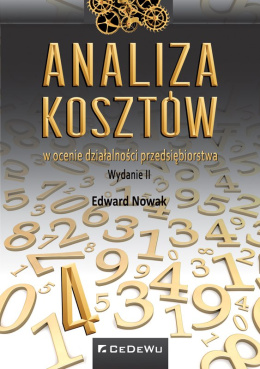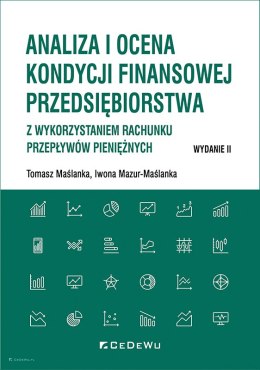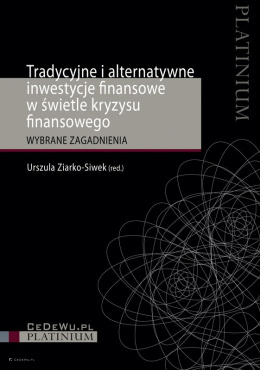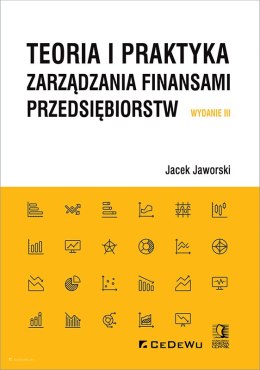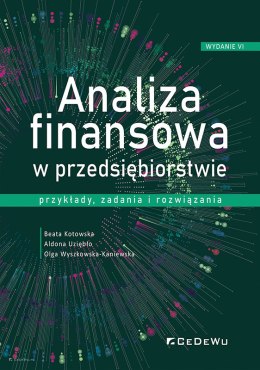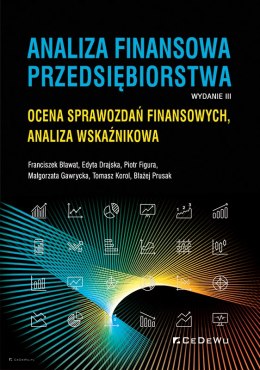- Kategorie
-
Odporność krajów na różnym poziomie rozwoju na ekonomiczne skutki światowego kryzysu finansowego oraz pandemii Covid-19

W książce przedstawiono zmiany w zakresie polityki makroekonomicznej, do których doszło w następstwie światowego kryzysu finansowego i w trakcie pandemii Covid-19. Badaniami objęto zmiany odporności krajów na takie pokryzysowe niekorzystne zjawi-ska makroekonomiczne jak akumulacja długu publicznego i dominacja fiskalna, zwiększona zmienność przepływów kapitału między-narodowego oraz ryzyko jego trwałego odpływu.
| Wysyłka w ciągu | 24 godziny |
| Kod kreskowy | |
| ISBN | 978-83-8102-565-2 |
| EAN | 9788381025652 |
W książce przedstawiono zmiany w zakresie polityki makroekonomicznej, do których doszło w następstwie światowego kryzysu finansowego i w trakcie pandemii Covid-19. Badaniami objęto zmiany odporności krajów na takie pokryzysowe niekorzystne zjawi-ska makroekonomiczne jak akumulacja długu publicznego i dominacja fiskalna, zwiększona zmienność przepływów kapitału między-narodowego oraz ryzyko jego trwałego odpływu. Analiza ogniskuje się wokół czterech wiodących pytań, którym poświęcono kolejne rozdziały:
• Czy aktywne wykorzystanie polityki fiskalnej do stabilizacji gospodarki okaże się trwałą zmianą i istotnie przyczyni się do większej stabilności makroekonomicznej?
• Czy akumulacja długu publicznego ogranicza pole decyzji w polityce pieniężnej i czy zależy ona od stosowanej strategii polityki pieniężnej?
• Czy zmiany otwartości finansowej były dodatkowym źródłem niestabilności finansowej i makroekonomicznej?
• Jak zmiany w polityce ekonomicznej i w otoczeniu instytucjonalnym zmieniły podatność gospodarek wschodzących na trwały od-pływ kapitału w okresie pandemii?
„Recenzowana monografia stanowi bardzo ciekawe, inspirujące, wielowątkowe studium badawcze dotyczące interakcji zachodzących między poszczególnymi politykami makroekonomicznymi realizowanymi w krajach pozostających na zróżnicowanym poziomie rozwoju, w odpowiedzi na wyzwania i zjawiska towarzyszące dwóm ostatnim kryzysom o zasięgu globalnym".
Dr hab. Joanna Bogołębska, prof. Uniwersytetu Łódzkiego, fragment recenzji
„Książka (...) będzie stanowiła cenne źródło wiedzy dla badaczy i praktyków zainteresowanych problematyką polityki ekonomicznej i koniunktury gospodarczej (...). Ponadto, książka powinna wzbudzić również zainteresowanie studentów kierunków ekonomicznych".
Dr hab. Sylwia Pangsy-Kania, prof. Uniwersytetu Gdańskiego, fragment recenzji
Wstęp 7
Rozdział 1
Zmiany w polityce fiskalnej w krajach na różnym poziomie rozwoju w reakcji na światowy kryzys finansowy i pandemię Covid-19 - Łukasz Jabłoński 11
1.1. Uwagi wstępne 11
1.2. Okres przed światowym kryzysem finansowym lat 2007-2009 12
1.3. Kryzys finansowy pierwszej dekady XXI wieku 19
1.4. Ogłoszenie pandemii Covid-19 jako wyzwanie dla polityki gospodarczej 24
1.5. Uwagi końcowe 31
Bibliografia 33
Rozdział 2
Polityka pieniężna w warunkach zagrożenia dominacją fiskalną wywołanego światowym kryzysem finansowym i pandemią Covid-19
- Marek A. Dąbrowski 39
2.1. Uwagi wstępne 39
2.2. Kwestie terminologiczne 41
2.3. Przegląd literatury 47
2.4. Ramy teoretyczne 51
2.5. Metodologia 53
2.6. Opis danych 55
2.7. Wyniki empiryczne 59
2.8. Uwagi końcowe 70
Bibliografia 72
Rozdział 3
Zmiany otwartości finansowej w krajach na różnym poziomie rozwoju w warunkach zaburzeń wywołanych globalnym kry-zysem finansowym oraz pandemią Covid-19 - Paweł Kawa 77
3.1. Uwagi wstępne 77
3.2. Kierunki badań nad otwartością finansową w krajach na średnim i wysokim poziomie rozwoju - perspektywa pokryzysowa 81
3.3. Zmiany poziomu otwartości finansowej w dobie kryzysów 91
3.4. Uwagi końcowe 97
Bibliografia 100
Rozdział 4
Reakcja przepływów kapitału na globalny kryzys finansowy oraz pandemię Covid-19 - Andrzej Wojtyna 103
4.1. Uwagi wstępne 103
4.2. Postęp w badaniach nad przepływami kapitału w okresie przed pandemią 104
4.3. Zmiany w przepływach kapitału w wyniku pandemii 121
4.4. Uwagi końcowe 126
Bibliografia 127
Spis tabel 131
Spis rysunków 132
Recenzenci:
Dr hab. Sylwia Pangsy-Kania, profesor Uniwersytetu Gdańskiego
Dr hab. Joanna Bogołębska, profesor Uniwersytetu Łódzkiego
Abbas S.A., Belhocine N., ElGanain A., Horton M. (2010). A Historical Public Debt Database. WP/10/245. IMF Working Paper. International Monetary Fund. https://www.imf.org/external/pubs/ft/wp/2010/wp10245.pdf.
Adrian T., Gopinath G., Gourinchas P.-O., Pazarbasioglu C., Weeks-Brown R. (2022). Why the IMF is Updating its View on Capital Flows, IMF Blog, March 30.
Adrian T., Gopinath G., Pazarbasioglu C. (2020). Navigating Capital Flows – An Integrated Approach, IMF Blog, December 9.
Ahmed R., Aizenman J., Jinjarak Y. (2021). Inflation and Exchange Rate Targeting Challenges Under Fiscal Dominance. Journal of Macroeconomics, 67, 103281. https://doi.org/10.1016/J.JMACRO.2020.103281.
Aizenman J. (2005). Financial Liberalization: How Well Has It Worked for Developing Countries?, Federal Reserve Bank of San Francisco Economic Letter, nr 6.
Aizenman J., Jinjarak Y., Nguyen H., Noy I. (2021). The Political Economy of the COVID-19 Fiscal Stimulus Packages of 2020. w29360. National Bureau of Economic Research. https://doi.org/10.3386/w29360.
Aksman E. (2017). Do Poverty and Income Inequality Affect Public Debt? Gospodarka Narodowa. The Polish Journal of Economics 292 (6): 79-93. https://doi.org/10.33119/GN/100744.
Alcidi C., Gros D., Giovannini A., Vogel L., Belke A., Callan T., Keane C., Savage M., Walsh J.R., Colgan B. (2014). Crisis-Induced Fiscal Restructuring in Europe. Intereconomics 49 (6): 300-322. https://doi.org/10.1007/s10272-014-0514-y.
Alesina A., Ardagna S. (2010). Large Changes in Fiscal Policy: Taxes versus Spending. Tax Policy and the Economy 24 (1): 35-68. https://doi.org/10.1086/649828.
Alesina A., Ardagna S., Galí J. (1998). „Tales of Fiscal Adjustment”. Economic Policy 13 (27): 489-545.
Allsopp C., Vines D. (2015). Monetary and Fiscal Policy in the Great Moderation and the Great Recession. Oxford Review of Economic Policy 31 (2): 134-67. https://doi.org/10.1093/oxrep/grv022.
Alpanda S., Honig A. (2014). The impact of central bank independence on the performance of inflation targeting regimes. Journal of International Money and Finance, 44, 118-135. https://doi.org/10.1016/J.JIMONFIN.2014.02.004.
Arcand J-L., Berkes E., Panizza U. (2012). Too Much Finance?, International Monetary Fund, WP/12/161, June.
Arslanalp S., Tsuda T. (2014a). Tracking Global Demand for Advanced Economy Sovereign Debt. Source: IMF Economic Review, 62(3), 430-464.
Arslanalp S., Tsuda T. (2014b). Tracking Global Demand for Emerging Market Sovereign Debt. IMF Working Paper, WP/14/39.
Auerbach A.J. (2012). The Fall and Rise of Keynesian Fiscal Policy. Asian Economic Policy Review 7 (2): 157-75. https://doi.org/10.1111/j.1748-3131.2012.01228.x.
Auerbach A.J., Gorodnichenko Y. (2012). Measuring the Output Responses to Fiscal Policy. American Economic Journal: Economic Policy 4 (2): 1-27. https://doi.org/10.1257/pol.4.2.1.
Auerbach A.J., Gorodnichenko Y. (2013). Fiscal Mulupliers in Recession and Expansion”. [w:] Fiscal Policy afer the Financial Crisis, pod red.: A. Alesina i F. Giavazzi. Chicago: University of Chicago Press, s. 63-98. http://www.nber.org/books/ales11-1.
Azzimonti M., de Francisco E., Quadrini V. (2014). Financial Globalization, Inequality, and the Rising Public Debt. The American Economic Review 104 (8): 2267-2302.
Bai J. (2009). Panel data models with interactive fixed effects. Econometrica, 77(4), 1229-1279.
Ban C. (2015). Austerity versus Stimulus? Understanding Fiscal Policy Change at the International Monetary Fund Since the Great Recession. Governance 28 (2): 167-83. https://doi.org/10.1111/gove.12099.
Banaszyk P., Deszczyński P., Gorynia M., Malaga K. (2021). Proposals for Modification of Selected Economic Concepts Amid the COVID-19 Pandemic. Gospodarka Narodowa. The Polish Journal of Economics 305 (1): 53-86. https://doi.org/10.33119/GN/132485.
Baranowski P. (2014). Reguły polityki pieniężnej w Polsce: podejście ilościowe. Łódź: Wydawnictwo Uniwersytetu Łódzkiego.
Barro R.J. (1979). On the Determination of the Public Debt. Journal of Political Economy, 87(5), 940-971. https://doi.org/10.1086/260807.
Barro, R.J. (1974). Are Government Bonds Net Wealth? Journal of Political Economy 82 (6): 1095-1117.
Batini N., Callegari G., Melina G. (2012). Successful Austerity in the United States, Europe and Japan. WP/12/190. IMF Working Paper. International Monetary Fund.
Baum A., Poplawski-Ribeiro M., Weber A. (2012). Fiscal Multipliers and the State of the Economy. WP/12/286. IMF Working Paper. International Monetary Fund.
Bean C. (2010). The Great Moderation, the Great Panic, and the Great Contraction. Journal of the European Economic Association 8 (2-3): 289-325. https://doi.org/10.1111/j.1542- 4774.2010.tb00505.x.
Beirne J., Renzhi N., Sugandi E., Volz U. (2020). Financial Market and Capital Flow Dynamics during the COVID-19 Pandemic, Asian Development Bank Institute Working Paper No. 1158, June.
Bergman U.M., Hutchison M. (2015). Economic stabilization in the post-crisis world: Are fiscal rules the answer? Adjustment in the Aftermath of the Global Crisis 2008-09: New Global Order? 52 (kwiecień): 82-101. https://doi.org/10.1016/j.jimonfin.2014.11.014.
BIS (2020). Capital flows, exchange rates and policy frameworks in emerging Asia, A report by a Working Group established by the Asian Consultative Council of the Bank for International Settlements, 27 November.
BIS (2021A). Changing patterns of capital flows, Committe on the Global Financial System, CGFS Papers, No. 66, May.
Blanchard O.J. (2004). Fiscal dominance and inflation targeting: Lessons from Brazil. NBER Working Paper, No. 10389. https://doi.org/10.2139/ssrn.518265.
Blanchard O.J. (2019). Public debt and low interest rates. American Economic Review, 109(4), 1197-1229. https://doi.org/10.1257/AER.109.4.1197.
Blanchard O.J., Leigh D. (2013). Growth Forecast Errors and Fiscal Multipliers. American Economic Review 103 (3): 117-20. https://doi.org/10.1257/aer.103.3.117.
Blot C., Cochard M., Creel J., Ducoudré B., Schweisguth D., Timbeau X. (2014). Fiscal consolidation in times of crisis: is the sooner really the better? Revue de l’OFCE N° 132 (1): 159-92.
Bogołębska J., Feder-Sempach E., Stawasz-Grabowska E. (2021). Uwarunkowania i wyzwania kreacji safe assets – szczególna rola długu publicznego”. Studia Prawno-Ekonomiczne 120 (grudzień): 141-59. https://doi.org/10.26485/SPE/2021/120/8.
Bogołębska J., Feder-Sempach E., Stawasz-Grabowska E. (2021). Uwarunkowania i wyzwania kreacji safe assets – szczególna rola długu publicznego. Studia Prawno-Ekonomiczne, 120(2021), 141-159. https://doi.org/https://doi.org/10.26485/SPE/2021/120/8.
Bohn H. (2007). Are stationarity and cointegration restrictions really necessary for the intertemporal budget constraint? Journal of Monetary Economics, 54(7), 1837-1847. https://doi.org/10.1016/j.jmoneco.2006.12.012.
Bordo M.D., Levy M.D. (2020). Do enlarged fiscal deficits cause inflation: The historical record. NBER Working Paper, No. 28195. https://doi.org/10.3386/W28195.
Boucekkine R., Fabbri G., Pintus P.A. (2018). Short-run pain, long-run gain: the conditional welfare gains from international financial integration, “Economic Theory”, 65(2).
Boussard J., Castro F. de, Salto M. (2012). Fiscal Multipliers and Public Debt Dynamics in Consolidations. European Economy – Economic Papers, nr 460 (lipiec). https://ideas.repec.org/p/euf/ecopap/0460.html.
Brahmbhatt M., Canuto O. (2012). Fiscal Policy for Growth and Development. Economic Premise, nr 91 (październik). https://doi.org/10/16795676/fiscal-policy-growth-development.
Brainard W.C. (1967). Uncertainty and the Effectiveness of Policy. The American Economic Review 57 (2): 411-25.
Brodeur A., Gray D., Islam A., Bhuiyan S. (2021). A Literature Review of the Economics of COVID-19”. Journal of Economic Surveys 35 (4): 1007-44. https://doi.org/10.1111/joes.12423.
Buffie E.F., Airaudo M., Zanna F. (2018). Inflation targeting and exchange rate management in less developed countries. Journal of International Money and Finance, 81, 159-184. https://doi.org/10.1016/J.JIMONFIN.2017.09.013.
Buiter W.H., Sibert A.C. (2018). The fallacy of the fiscal theory of the price level – one last time. Economics: The Open-Access, Open-Assessment E-Journal, 12, 2018-4. https://doi.org/http://dx.doi.org/10.5018/economics-ejournal.ja.2018-48.
Caballero R.J., Simsek A. (2018). Reach for Yield and Fickle Capital Flows. AEA Papers and Proceedings, 108.
Calvo G.A., Reinhart C.M. (2002). Fear of Floating. Source: The Quarterly Journal of Economics, 117(2), 379-408.
Canzoneri M.B., Cumby R.E., Diba B.T. (2001). Is the price level determined by the needs of fiscal solvency? The American Economic Review, 91(5), 1221-1238.
Carney M. (2019). Pull, Push, Pipes: Sustainable Capital Flows for a New World Order, speech given at Institute of International Finance Spring Membership Meeting, Tokyo, 6th June 2019, Bank of England.
Carrière-Swallow Y., David A.C., Leigh D. (2018). The Macroeconomic Effects of Fiscal Consolidation in Emerging Economies: Evidence from Latin America. Working Paper WP/18/142. International Monetary Fund.
Casanova C., Scheubel B., Stracca L. (2021). Old risks in new clothes: The changing nature of capital flows, Vox, June 4.
Castelnuovo E. (2007). Taylor rules and interest rate smoothing in the Euro area. Manchester School, 75(1), 1-16. https://doi.org/10.1111/j.1467-9957.2007.01000.x.
Centurión-Vicéncio M. (2021). A political economy essay on the fiscal and monetary interactions in Brazil. https://tel.archives-ouvertes.fr/tel-03263555.
Christiano L., Eichenbaum M., Rebelo S. (2011). When Is the Government Spending Multiplier Large? Journal of Political Economy 119 (1): 78-121. https://doi.org/10.1086/659312.
Christiano L., Fitzgerald T. (2000). Understanding the fiscal theory of the price level. Economic Review, 36(2), 1-38.
Ciarlone A., Colabella A. (2016). Spillovers of the ECB’s non-standard monetary policy into CESEE economies, Bank of Italy Occasional Paper No. 351.
Cogan J.F., Cwik T., Taylor J.B., Wieland V. (2010). New Keynesian versus old Keynesian government spending multipliers. Journal of Economic Dynamics and Control 34 (3): 281-95. https://doi.org/10.1016/j.jedc.2010.01.010.
Coibion O., Gorodnichenko Y. (2010). When will the Fed raise interest rates? Reconciling Taylor rule and financial market forecasts. https://voxeu.org/article/when-will-fed-raise-interest-rates.
Corsetti G., Meier A., Müller G.J., Devereux M.B. (2012). What determines government spending multipliers? Economic Policy 27 (72): 521-65.
Cui G., Norkutė M., Sarafidis V., Yamagata T. (2021). Two-Stage Instrumental Variable Estimation of Linear Panel Data Models with Interactive Effects. Lietuvos Bankas Working Paper, 90/2021.
Dąbrowski M.A. (2020). Globalny cykl finansowy jako ograniczenie niezależności w prowadzeniu polityki pieniężnej. [w:] P. Kawa, A. Wojtyna, J. Janus, M.A. Dąbrowski, Współzależności finansowe między krajami na różnym poziomie rozwoju po światowym kryzysie finansowym. Warszawa: Wydawnictwo Naukowe PWN, s. 66-88.
Dagher J. (2018). Regulatory cycles: Revisiting the political economy of financial crises, https://voxeu.org/article/regulatory-cycles-revisiting-political-economy-financial-crises (data dostępu: 5 listopada 2021 r.).
Daude C., Levy Yeyati E., Nagengast A. (2014). On the effectiveness of exchange rate interventions in emerging markets. OECD Development Centre Working Papers, 324.
David A.C., Goncalves C.E. (2019). In Search of Lost Time: Examining the Duration of Sudden Stops in Capital Flows, IMF Working Paper WP/19/230, November.
Davis S.J., Kahn J.A. (2008). Interpreting the Great Moderation: Changes in the Volatility of Economic Activity at the Macro and Micro Levels. The Journal of Economic Perspectives, 22(4), 155-180.
De Bock R., Drakopoulos D., Goel H., Gornicka L., Papageorgiou Schneider P., Server C. (2020). Managing volatile flows in emerging and frontier markets, CEPR, 19 August.
De Crescenzio A., Kokenyne A., Reinhart D., Schmidt J. (2020). Global policy response to capital flow volatility, OECD, 23 December.
De Crescenzio A., Lepers E. (2021). Extreme capital flows episodes from the Global Financial Crisis to COVID-19: An exploration with monthly data, OECD Working Papers on International Investment 2021/05.
De Gregorio J. (2014). Capital Flows and Capital Account Management, [w:] Akerlof G.A., Blanchard O., Romer D., Stiglitz J.E. (red.), What Have We Learned? Macroeconomic Policy after the Crisis, MIT Press, Cambridge, MA.
De Gregorio J. (2015). Managing Capital Flows in Frontier and Emerging Markets: What are the Lessons, Peterson Institute for International Economics, March.
De la Torre A., Ize A., Schmukler S.L. (2012). Financial Development in Latin America and the Caribbean: The Road Ahead, World Bank Latin American and Caribbean Studies, The World Bank.
De Long J.B., Summers L.H. (2012). Fiscal Policy in a Depressed Economy. Brookings Papers on Economic Activity, 233-74.
Deb P., Nadeem S., Peiris S.J. (2021). The Transmission of External Shocks in Asia: Country Characteristics and Policy Responses, IMF Working Paper WP/21/3, January.
Devereux M.P., Güçeri İ., Simmler M., Tam E.H.F. (2020). Discretionary Fiscal Responses to the COVID-19 Pandemic. Oxford Review of Economic Policy 36 (Supplement_1): S225-41. https://doi.org/10.1093/oxrep/graa019.
Dornbusch R., Reynoso A. (1989). Financial Factors in Economic Development, „American Economic Review”, 79(2).
Dufrénot G., Jawadi F., Khayat G.A. (2018). A model of fiscal dominance under the “Reinhart Conjecture.” Journal of Economic Dynamics and Control, 93, 332-345. https://doi.org/10.1016/j.jedc.2018.01.046.
Działo J. (2018). Skutki stabilizacyjnej polityki fiskalnej w krajach Unii Europejskiej w okresie kryzysu gospodarczego – próba oceny. Myśl Ekonomiczna i Polityczna 60 (1): 53-82. https://doi.org/10.26399/meip.1(60).2018.02/j.dzialo.
Ebeke C., Fouejieu A. (2018). Inflation targeting and exchange rate regimes in emerging markets. B.E. Journal of Macroeconomics, 18(2). https://doi.org/10.1515/BEJM-2017-0146/MACHINEREADABLECITATION/RIS.
Eberhardt M., Presbitero A.F. (2015). Public debt and growth: Heterogeneity and non-linearity. Journal of International Economics 97 (1): 45-58. https://doi.org/10.1016/j.jinteco.2015.04.005.
Eggertsson G.B. (2011). What Fiscal Policy Is Effective at Zero Interest Rates? NBER Macroeconomics Annual 25 (1): 59-112. https://doi.org/10.1086/657529.
Eguren Martin F., Joy M., Maurini C., Moro A., Nispi Landi V., Schiavone A., van Hombeeck C. (2020B). Capital flows during the pandemic: lessons for a more resilient international financial architecture, Bank of England Financial Stability Paper No.45, December.
Eguren Martin F., O’Neill C., Sokol A., von dem Berge L. (2020A). Capital flows-at-risk: push, pull and the role of policy, Bank of England Staff Working Paper No. 881.
Eguren-Martin F., Joy M., Maurini C., Moro A., Nispi Landi V., Schiavone A., Hombeeck C. (2020). Capital flows during the pandemic: lessons for a more resilient international financial architecture, Financial Stability Paper No. 45, December.
Eichengreen B. et al. (2021). Financial Globalization and Inequality: Capital Flows as a Two-Edged Sword, IMF Working Paper WP/21/4, January.
Eichengreen B., Gupta P., i Masetti O. (2017). Are Capital Flows Fickle? Increasingly? And Does the Answer Still Depend on Type? World Bank Policy Research Paper, 7972.
ElFayoumi K., Hengge M. (2021). Capital Markets COVID-19 and Policy Measures, IMF Working Paper no. WP/21/33.
Elgin C., Yalaman A., Sezer Y. (2021). Democracy and Fiscal-Policy Responses to COVID-19. 62/2021. CAMA Working Paper. Centre for Applied Macroeconomic Analysis, National Australian University.
Erceg C.J., Lindé J. (2012). Fiscal Consolidation in an Open Economy. American Economic Review 102 (3): 186–91. https://doi.org/10.1257/aer.102.3.186.
Fan J., Minford P., Ou Z. (2016). The role of fiscal policy in Britain’s Great Inflation. Economic Modelling, 58, 203-218. https://doi.org/10.1016/j.econmod.2016.05.027.
Favero C.A., Giavazzi F. (2004). Inflation targeting and debt: Lessons from Brazil. NBER Working Paper, No. 10390.
Fayad G., Poirson H. (2020). Caught in the Crosswinds: The Experiences of Selected Economies Responding to External Volatility with Multiple Policy Levers, IMF Working Paper, WP/20/225, November.
Fernandez R.B. (2020). Comparative Dynamics with Fiscal Dominance. Empirical Evidence from Argentina 2016-2019. Universidad Del Cema Documentos de Trabajo, 723. https://doi.org/10.2139/SSRN.3631220.
Ffrench-Davis R., Griffith-Jones S. (2014). Taming Capital Account Shocks: Managing Booms and Busts, [w:] Ocampo J.A., Ros J. (eds.), The Oxford Handbook of Latin American Economics, Oxford University Press, Oxford.
Forbes K.J., Warnock F.E. (2020). Capital Flow Waves – or Ripples? Extreme Capital Flow Movements Since the Crisis, NBER Working Paper No. 26851, March.
Frankel J.A., Vegh C.A., Vuletin G. (2013). On graduation from fiscal procyclicality. Journal of Development Economics 100 (1): 32-47. https://doi.org/10.1016/j.jdeveco.2012.07.001.
Friedman M. (1968). The Role of Monetary Policy. The American Economic Review 58 (1): 1-17.
Gadea M.D., Gómez-Loscos A., Pérez-Quirós G. (2018). Great Moderation And Great Recession: From Plain Sailing To Stormy Seas? International Economic Review 59(4): 2297-2321. https://doi.org/10.1111/iere.12337.
Gaiotti E., Secchi A. (2012). Monetary policy and fiscal dominance in Italy from the early 1970s to the adoption of the euro: a review. Banca d’Italia Questioni Di Economia e Finanza, No. 141.
Gelos G. et al. (2019). Capital Flows at Risk: Taming the Ebbs and Flows, IMF Workinhg Paper WP/19/279, December.
Ghosh A.R., Kim J.I., Mendoza E.G., Ostry J.D., Qureshi M.S. (2013). Fiscal Fatigue, Fiscal Space and Debt Sustainability in Advanced Economies. The Economic Journal 123 (566): F4-30. https://doi.org/10.1111/ecoj.12010.
Ghosh A.R., Ostry J.D., Qureshi M.S. (2017). Taming the Tide of Capital Flows. A Policy Guide, The MIT Press, Cambridge, MA.
Ghosh A.R., Ostry J.D., Qureshi M.S. (2017). Taming the Tide of Capital Flows. A Policy Guide, The MIT Press, Cambridge, MA.
Giavazz, F., Jappelli T., Pagano M. (2000). Searching for non-linear effects of fiscal policy: Evidence from industrial and developing countries. European Economic Review 44 (7): 1259-89. https://doi.org/10.1016/S0014-2921(00)00038-6.
Greene W.H. (2018). Econometric analysis. New Jersey: Prentice-Hall.
Grostal W., Ciżkowicz-Pękała M., Niedźwiedzińska J., Skrzeszewska-Paczek E., Stawasz E., Wesołowski G., Żuk P. (2015). Ewolucja strategii celu inflacyjnego w wybranych krajach. Warszawa: Narodowy Bank Polski.
Hale T., Angrist N., Goldszmidt R., Kira B., Petherick, A., Phillips T., Webster S., Cameron-Blake E., Hallas L., Majumdar S., Tatlow, H. (2021). A global panel database of pandemic policies (Oxford COVID-19 Government Response Tracker). Nature Human Behaviour 5 (4): 529-38. https://doi.org/10.1038/s41562-021-01079-8.
Hall R.E. (2009). By How Much Does GDP Rise If the Government Buys More Output? w15496. National Bureau of Economic Research. https://doi.org/10.3386/w15496.
Hamilton J.D. (2018). Why You Should Never Use the Hodrick-Prescott Filter. The Review of Economics and Statistics, 100(5), 831-843. https://doi.org/10.1162/REST_A_00706.
Haroutunian S., Osterloh S., Sławińska K. (2021). The initial fiscal policy responses of euro area countries to the COVID-19 crisis”. Economic Bulletin Articles 1 (luty). https://EconPapers.repec.org/RePEc:ecb:ecbart:2021:0001:3.
Havlik A., Heinemann F., Helbig S., Nover J. (2022). Dispelling the shadow of fiscal dominance? Fiscal and monetary announcement effects for euro area sovereign spreads in the corona pandemic. Journal of International Money and Finance, 122. https://doi.org/10.1016/J.JIMONFIN.2021.102578.
Heimonen K., Junttila J., Kärkkäinen S. (2017). Stock market and exchange rate information in the Taylor rule: Evidence from OECD countries. International Review of Economics and Finance, 51(May), 1-18. https://doi.org/10.1016/j.iref.2017.05.001.
Hofmann B., Bogdanova B. (2012). Taylor rules and monetary policy: A global “Great deviation”? BIS Quarterly Review, September, 37-49.
Hooley J., Nguyen L., Saito M., Nikaein T.S. (2021). Fiscal Dominance in Sub-Saharan Africa Revisited. IMF Working Paper, WP/21/17. https://doi.org/10.5089/9781513567747.001.
Humpage O.F. (2016). Fiscal Dominance and US Monetary: 1940-1975. Federal Reserve Bank of Cleveland Working Papers, 16-32.
Ilzetzki E., Mendoza E.G., Végh C.A. (2013). How big (small?) are fiscal multipliers? Journal of Monetary Economics 60 (2): 239-54. https://doi.org/10.1016/j.jmoneco.2012.10.011.
IMF (2012). The Liberalization and Management of Capital Flows: An Institutional View, IMF, Washington, D.C.
IMF (2015). Rethinking Financial Deepening: Stability and Growth in Emerging Markets. IMF, Washington, D.C.
IMF (2021). Fiscal Monitor. A Fair Shot. Washington, DC: International Monetary Fund. https://doi.org/10.5089/9781513571553.089.CH000.
Janicka M. (2010). Liberalizacja przepływów kapitałowych w gospodarce światowej. Przypadek Polski, Wydawnictwo Uniwersytetu Łódzkiego, Łódź.
Jevđović G., Milenković I. (2018). Monetary Versus Fiscal Dominance in Emerging European Economies. Facta Universitatis, Series: Economics and Organization, 15(1), 125-133. https://doi.org/10.22190/fueo1802125j.
Jia P. (2020). The macroeconomic impact of monetary-fiscal policy in a “fiscal dominance” world. Macroeconomic Dynamics, 24(3), 670-707. https://doi.org/10.1017/S13651005 18000408
Judson R.A., Owen A.L. (1999). Estimating dynamic panel data models: a guide for macroeconomists. Economics Letters, 65(1), 9-15. https://doi.org/10.1016/S0165-1765(99)00130-5.
Kalemli-Ozcan S. (2020). Emerging market capital flows under COVID: what to expect given what we know?, IMF, „Research”, September 16.
Karras G. (2014). Is Fiscal Policy More Effective During Cyclical Downturns? International Economic Journal 28 (2): 255-71. https://doi.org/10.1080/10168737.2013.825304.
Kawa P., Wajda-Lichy M., Fijorek K., Denkowska S. (2020). Do Finance and Trade Foster Economic Growth in the New EU Member States: Granger Panel Bootstrap Causality Approach, „Eastern European Economics”, 58(6).
Kenç T., Erdem F.P., Ünalmış İ. (2016). Resilience of emerging market economies to global financial conditions, „Central Bank Review”, 16.
Kirsanova T., Leith C., Wren-Lewis S. (2009). Monetary and Fiscal Policy Interaction: The Current Consensus Assignment in the Light of Recent Developments. The Economic Journal 119 (541): F482-96.
Kose M.A., Ohnsorge F., Reinhart C., Rogoff K. (2021). The Aftermath of Debt Surges, World Bank Policy Research Working Paper No. 9771.
Kose M.A., Ohnsorge F.L., Reinhart C.M., Rogoff K.S. (2021). The aftermath of debt surges. NBER Working Paper, No. 29266.
Kripfganz S., Sarafidis V. (2021). Instrumental-variable estimation of large-T panel-data models with common factors: The Stata Journal, 21(3), 659-686. https://doi.org/10.1177/1536867X 211045558.
Krugman P. (1988). Financing vs. forgiving a debt overhang. Journal of Development Economics 29 (3): 253-68. https://doi.org/10.1016/0304-3878(88)90044-2.
Kumhof M., Rungcharoenkitkul P., Sokol A. (2020). How does international capital flow?, BIS Working Paper No. 890, October.
Lacey E., Massad J., Utz R. (2021). A Review of Fiscal Policy Responses to COVID-19. Working Paper. World Bank, Washington, DC. https://openknowledge.worldbank.org/handle/10986/35904.
Laeven L., Valencia F. (2018). Systemic Banking Crises Revisited: IMF Working Paper, WP/18/206.
Lama R., Medina J.P. (2020). Shocks Matter: Managing Capital Flows in Emerging Economies with Multiple Instruments, IMF Working Paper WP/20/97, June.
Lang N., Őber J.,Rafith R., Schmidt N. (2021). Global Capital Flows in the Postpandemic World, Boston Consulting Group, June 16.
Ledóchowski M., Żuk P. (2020). What drives portfolio capital inflows into emerging market economies? The role of the Fed’s and ECB’s balance sheet policies. NBP Working Paper No. 333.
Leeper E.M., Leith C. (2016). Understanding inflation as a joint monetary – fiscal phenomenon. [w:] J.B. Taylor, H. Uhlig (red.), Handbook of Macroeconomics (Vol. 2). Amsterdam-Oxfrod: Elsevier, s. 2305-2415. https://doi.org/10.1016/BS.HESMAC.2016.03.012.
Leeper Eric M. (1991). Equilibria under ‘active’ and ‘passive’ monetary and fiscal policies. Journal of Monetary Economics, 27(1), 129-147. https://doi.org/10.1016/0304-3932(91)90007-B.
Levine R. (2001). International Financial Liberalization and Economic Growth, „Review of International Economics”, November.
Lindert P.H. (1986). Unequal English Wealth since 1670. Journal of Political Economy 94 (6): 1127-62.
Lorenzoni G., Werning I. (2019). Slow Moving Debt Crises. American Economic Review, 109(9), 3229-3263. https://doi.org/10.1257/AER.20141766.
Lubiński M. (2010). Polityka fiskalna wobec kryzysu finansowego. Próba oceny. Gospodarka Narodowa. The Polish Journal of Economics 242 (9): 1-23. https://doi.org/10.33119/GN/101138.
Lucas R.E. (1976). Econometric Policy Evaluation: A Critique. Carnegie-Rochester Conference Series on Public Policy 1 (styczeń): 19-46. https://doi.org/10.1016/S0167-2231(76)80003-6.
Lucas R.E. (1990). Why Doesn’t Capital Flow from Rich to Poor Countries?”, American Economic Review, Paper and Proceedings 80, May.
Mackiewicz-Łyziak J. (2015). Fiscal sustainability in CEE countries - the case of the Czech Republic, Hungary and Poland. Equilibrium. Quarterly Journal of Economics and Economic Policy, 10(2), 53-71. https://doi.org/10.12775/EQUIL.2015.013.
Magud N.E., Reinhart C.M., Rogoff K.S. (2018). Capital Controls: Myth and Reality, Annals of Economics and Finance, 19(1).
Makin A.J., Layton A. (2021). The global fiscal response to COVID-19: Risks and repercussions. Economic Analysis and Policy 69 (marzec): 340-49. https://doi.org/10.1016/j.eap.2020.12.016.
Martin P., Rey H. (2006). Globalization and Emerging Markets: With or Without Crash?, “American Economic Review” nr 5.
Martinelli C., Vega M.A. (2018). Monetary and Fiscal History of Peru 1960-2010: Radical Policy Experiments, Inflation and Stabilization. George Mason University Interdisciplinary Center for Economic Science Working Paper, 18-21. https://doi.org/10.2139/ssrn.3241872.
Masson P.R., Savastano M.A., Sharma S. (1997). The Scope for Inflation Targeting in Developing Countries. IMF Working Paper, WP/97/130.
Mazzucato M., Kattel R. (2020). COVID-19 and public-sector capacity. Oxford Review of Economic Policy 36 (Supplement_1): S256-69. https://doi.org/10.1093/oxrep/graa031.
Meade J. (1978). The Meaning of “Internal Balance”. The Economic Journal 88 (351): 423-35. https://doi.org/10.2307/2232044.
Meza F. (2018). Mexico from the 1960s to the 21st century: From fiscal dominance to debt crisis to low inflation. Centro de Investigacion Economica, ITAM Working Papers. http://dx.doi.org/10.2139/ssrn.3182594.
Minford P. (2017). Comments on Buiter and Sibert, Invited Reader Comment. Economics: The Open-Access, Open-Assessment E-Journal, 2017-84.
Minford P., Ou Z., Wickens M. (2015). Revisiting the Great Moderation: Policy or Luck? Open Economies Review 26 (2): 197-223. https://doi.org/10.1007/s11079-014-9319-7.
Minsky H. (1991). The Financial Instability Hypothesis: A Clarification, [w:] Feldstein M. (red.), The Risk of Economic Crisis, University of Chicago Press, Chicago.
Mishkin F.S. (1997). Understanding Financial Crises: A Developing Country Perspective, NBER Working Papers 5600.
Molodtsova T., Papell D.H. (2013). Taylor rule exchange rate forecasting during the financial crisis. [w:] F. Giavazzi, K.D. West (red.), NBER International Seminar on Macroeconomics 2012. Chicago: The University of Chicago Press, s. 55-97. https://doi.org/10.2139/ssrn.2149215.
Morys M. (2021). The gold standard, fiscal dominance and financial supervision in Greece and South-East Europe, 1841-1939. European Review of Economic History, 25(1), 106-136. https://doi.org/10.1093/EREH/HEAA006.
Nickell S. (1981). Biases in Dynamic Models with Fixed Effects. Econometrica, 49(6), 1417-1426. https://doi.org/10.2307/1911408.
Norkutė M., Sarafidis V., Yamagata T., Cui G. (2021). Instrumental variable estimation of dynamic linear panel data models with defactored regressors and a multifactor error structure. Journal of Econometrics, 220(2), 416-446. https://doi.org/10.1016/J.JECONOM.2020.04.008.
Obstfeld M. (2021). An Uneven Global Rebound Threaten Sustainable Recovery Everywhere, [w:] Macroeconomic Policy in an Uneven Economy, Jackson Hole Economic Policy Symposium, August 27.
OECD (2021). Government at a Glance 2021. Text. Paris: OECD Publishing. https://doi.org/10.1787/1c258f55-en.
Ötker-Robe I., Freedman C. (2010). Important Elements for Inflation Targeting for Emerging Economies. IMF Working Papers, WP/10/113. https://doi.org/10.5089/9781455200726.001.
Padoan P.C. (2009). Fiscal Policy in the Crisis: Impact, Sustainability, and Long-Term Implications. 178. ADBI Working Paper Series. Tokyo: Asian Development Bank Institute. http://www.adbi.org/working-paper/2009/12/14/3418.fiscal.policy.crisis/.
Padoan P.C., Sila U., Van den Noord P. (2012). Avoiding Debt Traps: Financial Backstops and Structural Reforms. 976. OECD Economics Department Working Papers. OECD Publishing. https://doi.org/https://doi.org/10.1787/5k962hhtt5mr-en.
Perotti R. (1999). Fiscal Policy in Good Times and Bad. The Quarterly Journal of Economics 114 (4): 1399-1436. https://doi.org/10.1162/003355399556304.
Pesaran M.H. (2006). Estimation and Inference in Large Heterogeneous Panels with a Multifactor Error Structure. Econometrica, 74(4), 967-1012. https://doi.org/10.1111/J.1468- 0262.2006.00692.X.
Pesaran M.H. (2015). Testing Weak Cross-Sectional Dependence in Large Panels. Econometric Reviews, 34(6-10), 1089-1117. https://doi.org/10.1080/07474938.2014.956623.
Peters M.A., Jandrić P. (2021). Surreal economics, fiscal stimulus, and the financialization of public health: Politics of the covid-19 narrative. Educational Philosophy and Theory, maj, 1-6. https://doi.org/10.1080/00131857.2021.1929170.
Przybylska-Kapuścińska W. (2006). Strategia bezpośredniego celu inflacyjnego w polityce pieniężnej banków centralnych. Ruch Prawniczy, Ekonomiczny i Socjologiczny, 68(4), 111-129.
Ranciere R., Tornell A., Westermann F. (2006). Decomposing the Effects of Financial Liberalization: Crises vs. Growth, NBER Working Papers 12806.
Reinhart C., Rogoff K. (2008). This Time is Different: A Panoramic View of Eight Centuries of Financial Crises, NBER Working Papers 13882.
Reinhart C.M., Reinhart V.R., Rogoff K.S. (2012). Public Debt Overhangs: Advanced-Economy Episodes since 1800. Journal of Economic Perspectives 26 (3): 69-86. https://doi.org/10.1257/jep.26.3.69.
Reinhart C.M., Rogoff K.S. (2010). Growth in a Time of Debt. American Economic Review 100 (2): 573-78. https://doi.org/10.1257/aer.100.2.573.
Sabaté M., Escario R., Gadea M.D. (2015). Fighting fiscal dominance. The case of Spain, 1874-1998. European Review of Economic History, 19(1), 23-43. https://doi.org/10.1093/EREH/HEU020.
Saffie F., Varela L., Yi K.-M. (2020). The Micro and Macro Dynamics of Capital Flows, NBER Working Paper, No. 27371.
Sargent T.J., Wallace N. (1981). Some Unpleasant Monetarist Arithmetic. Federal Reserve Bank of Minneapolis Quarterly Review, 5(3), 117.
Sims C.A. (1994). A simple model for study of the determination of the price level and the interaction of monetary and fiscal policy. Economic Theory, 4(3), 381-399.
Stiglitz J.E. (1994). The Role of the State in Financial Markets, Proceedings of The World Bank Annual Conference on Development Economics 1993, The World Bank.
Stiglitz J.E. (2004). Globalizacja, Wydawnictwo Naukowe PWN, Warszawa.
Taleb N.N (2020). Czarny Łabędź. Jak nieprzewidywalne zdarzenia rządzą naszym życiem, Wydawnictwo Zysk i S-ka, Poznań.
Tanner E., Ramos A.M. (2003). Fiscal sustainability and monetary versus fiscal dominance: Evidence from Brazil, 1991-2000. Applied Economics, 35(7), 859-873. https://doi.org/10.1080/0003684032000056832.
Taylor J.B. (1993). Discretion versus policy rules in practice. Conference Series on Public Policy, 39, 195-214.
Taylor J.B. (2001). The role of the exchange rate in monetary-policy rules. American Economic Review, 91(2), 263-267.
The Global Economic Outlook During the COVID-19 Pandemic: A Changed World (2020), The World Bank.
The Global Risk Report(2020). World Economic Forum.
The Great Lockdown: Worst Economic Downturn Since the Great Depression(2020). International Monetary Fund.
Trichet J.C. (2017). The Evolution of the Financial System and the Efficiency of Intermediaries and Markets, [w:] De Rosa L. (ed.) International Banking and Financial Systems: Evolution and Stability, Routledge, London.
Turner A. (2016). Between Debt and the Devil. Money, Credit, and Fixing Global Finance, Princeton University Press, Princeton.
Wachtel P. (2003). How Much Do We Really Know about Growth and Finance, Federal Reserve Bank of Atlanta Economic Review, First Quarter.
Watkins B. (2016). An End to Fiscal Dominance: We need to find a way to separate our fiscal and monetary policies. https://www.city-journal.org/html/end-fiscal-dominance-14582.html?wallit_nosession=1.
Wojtyna A. (1998). Nowe trendy w zachodniej teorii ekonomii. Kraków, Akademia Ekonomiczna w Krakowie.
Wojtyna A. (2003). Polityka makroekonomiczna w cyklu koniunkturalnym – nowe nurty w teorii. Gospodarka Narodowa. The Polish Journal of Economics 184 (5-6): 1-22. https://doi.org/10.33119/GN/113783.
Wojtyna A. (2007). Teoretyczny wymiar zależności między zmianami instytucjonalnymi, polityką ekonomiczną a wzrostem gospodarczym. Gospodarka Narodowa. The Polish Journal of Economics 216 (5-6): 1-23. https://doi.org/10.33119/GN/101367.
Wojtyna A. (2020). Nowe kierunki badań nad międzynarodowymi przepływami kapitału, [w:] Kawa P., Wojtyna A., Janus J., Dąbrowski M.A., Współzależności finansowe między krajami na różnym poziomie rozwoju po światowym kryzysie finansowym, PWN, Warszawa.
Woo J., Kumar M.S. (2015). Public Debt and Growth. Economica 82 (328): 705-39.
Woodford M. (1995). Price-level determinacy without control of a monetary aggregate. Carnegie-Rochester Conference Series on Public Policy, 43(C), 1-46. https://doi.org/10.1016/0167-2231(95)90033-0.
Woodford M. (2003). Interest and prices: foundations of a theory of monetary policy. Princeton, Oxford: Princeton University Press.
World Bank (2020). Kose M.A., Ohnsorge F. (red.) A Decade after the Global Recession. Lessons and Challenges for Emerging and Developing Economies, Washington DC.
World Bank (2020). The Fiscal Impact and Policy Response to COVID-19. Working Paper. Washington, DC: World Bank. https://openknowledge.worldbank.org/handle/10986/35424.
Yepez J.F. (2021). Unintended Consequences of U.S. Monetary Policy Shocks: Dutch Disease and Capital Flow Masures in Emerging Markets and Developing Economies, IMF Working Paper WP/21/209.
Zhang Y., Thelen N., Rao A. (2010). Social Protection in Fiscal Stimulus Packages: Some Evidence”. A UNDP/ODS Working Paper. New York: United Nations Development Programme.
Polub nas na Facebooku

